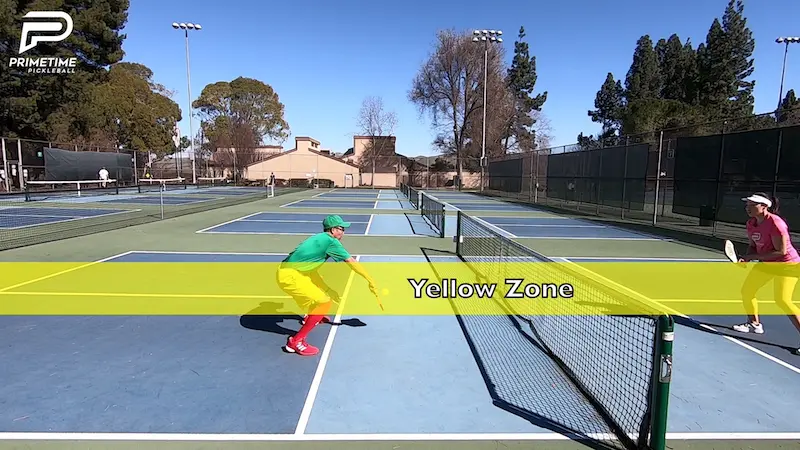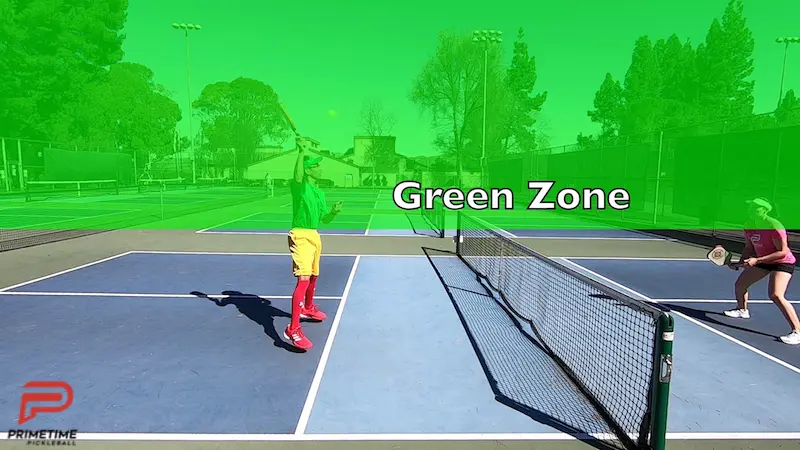You’re probably wondering why I’m wearing this outfit (see video thumb nail below).
In this video/blog I’m going to explain that and we’re going to talk about when to attack from the non-volley zone.
With this outfit today, I think it’s a really good visual for you. I want you to think about a traffic light with the green, the yellow and the red.
From my knees to my toes I have red so we’ll refer to this as the red zone.
My shorts from my knees up until my waist or belly button area is the yellow zone.
Then, from my belly button waist area up to my head and beyond is the green zone.
We’re going to talk about these three zones today and how they are really important when deciding on when to attack.
We’re going to talk about this from the bottom up and we’re going to start with the red zone.
Red Zone

When you’re at a traffic light and you see a red light what do you think?
First of all it means stop and secondly if you go beyond that red light it’s very dangerous.
That’s something that I want you to keep in mind. The red zone is an area where you shouldn’t attack from. If you are attacking from the red zone it is very dangerous in a sense.
Firstly, the net is right in front of you so if you try to attack from that low of a contact in the red zone you have a high probability of hitting that net.
Secondly, if you choose to attack the ball from the red zone and you don’t hit the ball into the net you will be prone to hitting the ball out.
If you’re attacking from the red zone and you want to get the ball into the court you will have to either have tremendous top spin on the ball or you will have to hit the ball very slow which will not defeat your opponent’s reaction time and will give them an easy opportunity to counter attack down at your feet.
Also, every time you contact the ball from the red zone or way below the net, your ball trajectory will be going up which will always allow your opponent to hit down at your feet.
One other reason why it’s not good to attack from the red zone is that it develops bad habits. Even though you may get away with it once in a while it’s definitely not a high percentage play.
You will end up losing more points than you win and become more impatient.
So what should you do instead if you hit or contact a ball from the red zone? Hit a reset shot or an unattackable ball, which is a neutral ball, so that your opponent can’t hurt you on the next ball.
Now that we talked about the red zone, let’s now talk about the yellow zone.
Yellow Zone

Think about a traffic light when you’re in your driving in your car and you’re going to come through an intersection when you see that yellow light.
What are you thinking?
You’re probably thinking be cautious or slow down.
In this example, I think cautious is the right word.
When you have that yellow light you have a decision to make. Are you going to stop before the intersection or are you going to speed up and go through?
I think this is a really good example of the decision making you’re going to have to make on the court. When you get balls in this yellow zone that’s the decision making part that really comes into play. You can attack that ball or you can hit a neutral ball.
When making contact in the yellow zone, be cautious. This is the decision-making zone.
This is when you can make contact with the ball slightly below the net and you can hit the ball with a good amount of pace using topspin.
When you’re hitting this ball you’re trying to do one of two things. Number one, you are trying to defeat your opponent’s reaction time or surprise them or number two, you are trying to force them to have a weak or bad contact point.
Your ball trajectory for the shot won’t be as low to high as attacking from the red zone although you will still have to hit with the upward trajectory. Because of this you must be cautious of the counter attack.
Players with great hands and volleys can counter attack your initial attack from the yellow zone so you will have to be very picky on when to attack from here.
All that to say, know the counter-attacking skills of your opponent.
Now when you get a ball in this yellow zone you have one of two options. The first one is to attack in order to jam or rush your opponent like we just talked about. The second option is to reset it and hit a neutral ball and wait for a better opportunity to attack.
Now that we talked about this yellow zone let’s jump into the green zone.
Green Zone

This is the zone that is everyone’s favourite. It’s a ball that you get that’s above net level and that you can hit down on.
So, using the traffic light analogy, when you have a green light that means go. So, when you have a ball that you can hit down on that’s in your green zone you should go for it and attack that ball.
This is a ball that you can attack and have a contact point around net level or higher.
You will have the ability to hit the ball with a straight trajectory while attacking with a lot of pace. Or, you may even be able to hit with a downward trajectory which is ideal because it will force your opponents to hit up on the ball and force them to be on the defense.
They will end up having to hit a neutral or defensive ball.
Every time you can contact the ball in your green zone you always want to make sure that you hit the ball to your opponent’s red zone. This means that they will most likely not have the ability to counter attack.
So, when attacking, especially from the green zone, there are three things that I like to think about that make a great attack. Placement, pace and a low contact point.
Placement of the ball is key. If you can make your opponents stretch and reach and not hit it right to their paddle.
Pace is also important. Obviously the faster you hit the ball the less reaction time your opponent is going to have.
The third thing that makes a great attack is a low contact point. If you can consistently make your opponents hit from a low contact point, specifically in the red zone, you will have a better chance of winning the game every time.
Even if you have to take some pace off the ball to get it more down at their feet and force a lower contact point than do that.
Getting the ball down back at your opponent’s red zone is better than attacking the ball with more pace to their yellow or green zone.
Remember this is just a good visual to help you think about which balls to attack and which to reset or hit a neutral ball.
To recap, if you’re contacting the ball down below in this red zone that is a really dangerous place to attack from. So, reset those balls.
Now, in this yellow zone that’s a decision making zone, and you’re going to have to decide when you’re going to pull the trigger and attack and when you’re going to reset the shot. Remember the counter attacking skills of your opponent is a big part of that decision making.
Anything in the green, as you move up in levels, it’s going to be harder and harder to get balls hit up to this green zone. When you get balls up here this high go for them. Take that opportunity and put those balls away if you can.
I really hope you enjoyed this video/blog. Happy Pickeling!